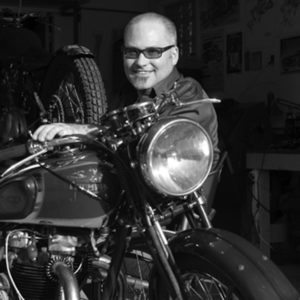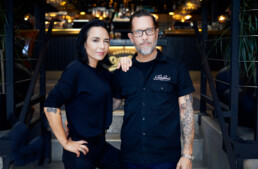It’s lucky Number 13 for Mecum Auctions and the company’s Monterey, California event. Having held its inaugural Monterey auction in 2009, the event returns to the Hyatt Regency Monterey Hotel and Spa on the Del Monte Golf Course from August 12 to 14, 2021. Selling automobiles, engines, tractors, art, and a selection of motorcycles, Monterey ‘21 offers more than 600 lots at a time when the market seems hot. “The collector vehicle market, including motorcycles, has been very strong for us throughout the multiple auctions we’ve found ways to present in the last year,” says Greg Arnold, Director of Mecum Auctions’ Motorcycle Division. He adds, “(And at) the postponed Las Vegas Motorcycle auction, records continued to be set, nonetheless. We fully expect the Monterey Motorcycle auction to continue in the same vein, the line-up is diverse with an added emphasis on sporting motorcycles.”
There are 59 motorcycles available at the time of writing but picking a Top 5 list is difficult. There’s a collection of small-bore Ducati singles – all cool. And there are some intriguing American singles, twins and fours (1903 Mitchell, 1927 Indian Scouts, 1917 Henderson racer), British singles and twins (BSA Gold Stars, Vincent HRD Series A and a first year 1959 Triumph Bonneville), and exotic, high-revving, high-horsepower European sport bikes (Aprilias and Bimotas). But here’s what my esoteric heart would choose at Monterey 2021.

Having just written ‘Almost Lost: A Cross-Country Pioneer’ for TheVintagent.com, this 1915 Harley-Davidson Model 11-F piqued my interest. In that story, Canadian Motorcycle-Naturalist Hamilton Mack Laing trekked across America in 1915 aboard Barking Betsy, his brand-new 1,000cc Model 11-F. While the ride wasn’t a cakewalk, it was somewhat easier to accomplish thanks to advances made by Harley-Davidson on this particular model. For example, 1915 was the first year for a hand-shift, three-speed transmission with foot-operated clutch, and an automatic oiling system. Engine internals were beefed-up, and horsepower increased over the 1914 Model 10-F. Nineteen fifteen was the last year for the square-style gas tank and the pedal cranks. This particular example is a stunning restoration of a machine found in the early 1970s on a Nebraska farm. It was apart, but most of the important bits, including engine case halves with matching belly numbers, were present. It changed hands in 1996 at the Davenport AMCA swap meet but wasn’t completely restored until the downtime provided by the COVID pandemic. This 11-F also bristles with period accessories including a carbide lighting system, Corbin Brown speedometer and klaxon horn. It’s not Barking Betsy, but it’s a fine example.

George Brough, son of William Edward Brough, left his father’s firm in 1919 to build a better motorcycle. Setting up shop in Nottinghamshire, full production of George’s machines began in 1920 and, to differentiate his models from those his father built, called them Brough Superior. The first production Brough Superior was the Mark I model, with a 1,000cc overhead valve V-twin engine produced by J.A. Prestwich, or J.A.P. The race-designed ’90-Bore’ overhead-valve engine was installed in Brough’s own solidly constructed diamond frame. Power was transferred through a Sturmey-Archer three-speed transmission and brakes were rather simplistic bicycle-style components. Chains were used for both primary and final drive when many companies were still employing belt rear drives. What really set the Brough Superior apart from everything else was the streamlined nickel-plated ‘saddle’ gas tank – and Brough, a man who had no trouble with words, described the motorcycle as an ‘atmosphere disturber’. Indeed. One of two 1922 Mark 1 90 Bore models known to exist, the restoration of this particular example appears impeccably done and was a concours winner in October 2019 at Motorclassica; the annual Australian International Concours d’Elegance & Classic Motor Show.

Little more than a decade after introducing his first scooter, Foster Salsbury’s eponymous company was financially on the ropes. California-based Salsbury introduced the two-stroke powered Motor-Glide in 1936 and was a pioneer in the American motor-scooter market. Chief among his innovations was a continuously variable transmission that was introduced on the third-generation 1938 and ’39 Motor-Glide Models 40 through 60. Gone was the two-stroke engine, replaced by a four-stroke Johnson in the second generation Aero and Aero 30, and that’s when Salsbury enclosed the mechanicals with a sheet metal body. The Second World War years stalled much of Salsbury’s progress, but he did come out with the streamlined Model 85 in 1946. It featured foot-operated throttle and brake pedals, just like an automobile, and looked modern and sleek in its fresh body work. There is a 6-horsepower powerplant under the rider’s seat, and a massive storage trunk at the rear. Approximately 700 to 1,000 Model 85s left the factory before bankruptcy was declared in 1948, and these machines always delight the collectors. This particular Model 85 doesn’t appear ready to ride. The entire engine has been sprayed orange (it shouldn’t have been), and the lack of a drive chain from the CVT’s jackshaft to the rear wheel sprocket indicates some fettling will be required.

Few machines have impacted the motorcycle market quite like the Honda CB750 Four. Arguments for other machines that have shaken the industry can be made, but when the inline four-cylinder CB750 was introduced in 1969 the motorcycle was literally a game-changer. With a four-cylinder engine featuring electric starter, Honda’s CB750 with its front disc brake became the machine that set the pace for the early part of the 1970s. The Candy Ruby Red CB750 featured here was built in October 1969 and was restored using OEM parts. It includes correct Honda keys and a complete tool kit. Some 13,000 miles are indicated on the odometer, presumably accumulated pre-restoration as the machine has never had gasoline in the tank post-resto. As good as the paint and chrome looks, the spokes and hubs appear to still be in original condition. A good friend of mine says never buy a restored motorcycle that hasn’t covered more than 500 miles since completion. If the buyer intends to ride this CB750, be prepared to work on some fine-tuning of the ride. If it’s going into a collection for display only, it’s a very pretty example.

In the early 1960s when Massimo Laverda and his chief engineer Luciano Zen decided to build a powerful sport bike for the all-important American market, they studied a Honda CB77 Super Hawk. The Hawk’s 305cc engine, with horizontally split crankcase, unit construction gearbox, overhead camshaft, 12-volt electrics and push button starter was the one to emulate for their project. Laverda had a running prototype of a 650 twin ready in 1965 but nothing appeared on the market until 1968, when a 750cc prototype had been built and tested. In 1968, both 650cc and 750cc motorcycles were sold but Laverda soon dropped the 650. The larger machine became two models, the 750 GT and more sporting 750 S. In 1970-71, Laverda debuted the 750 SF with a reworked chassis, improved brakes (SF stands for Super Freni, or Super Brakes), better clutch, and lightened crankshaft. On offer here is a 1973 750 SF from the Northern California Superbike Collection that is reportedly mostly original, with 1,266 miles on the Nippon Denso odometer. It’s believed the gas tank has been repainted, but there are signs of age, with a seam separation on the seat and other scuffs and marks. All are good indicators this is an honest survivor of a rare Italian machine that would have originally been sold in the European market, with its right side foot shifter and left side rear brake lever.
[Note: Mecum Auctions is a sponsor of TheVintagent.com]
Related Posts
December 21, 2018
The Vintagent Selects: The MC Collection Of Stockholm // Mecum Las Vegas Motorcycles 2019
This is the MC Collection.
March 15, 2017




The usual nice straight forward article, I always like your picks and the rationale for them. One note though, USDOT did not require left-side shift conformity until 1975. Harley-Davidson Sportsters and Triumph did not switch to left-side until then, I doubt Laverda would have either.
Agreed: Greg might be correct that this is a Euro-spec model, but the right-side shift was typical for Italian bikes until manufacturers were forced to conform to American standards, as you note. My Ducati 750GT/Sport twins always had right shift, and my 860/960GTS (1975+) came with left – but could easily be converted back to right shift as per Euro spec. I preferred right shift as all my British bikes were the same.